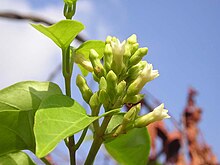Urceola polymorpha
| Urceola polymorpha | |
|---|---|

| |
| Aganonerion polymorphum | |
| Scientific classification | |
| Kingdom: | Plantae |
| Clade: | Tracheophytes |
| Clade: | Angiosperms |
| Clade: | Eudicots |
| Clade: | Asterids |
| Order: | Gentianales |
| Family: | Apocynaceae |
| Subfamily: | Apocynoideae |
| Tribe: | Apocyneae |
| Genus: | Aganonerion Pierre ex Spire |
| Species: | A. polymorphum
|
| Binomial name | |
| Aganonerion polymorphum Spire
| |
Aganonerion is a plant genus in the family Apocynaceae, first described in 1905. It contains only one known species, Aganonerion polymorphum, native to Indochina (Thailand, Laos, Cambodia, Vietnam).[1][2]
Aganonerion polymorphum is used medicinally and as a food, appearing for example in a traditional Vietnamese soup called canh chua. In Vietnamese, the plant is called lá giang, literally "river leaf." In Cambodia, it is called /vɔə tʰnɜŋ/ (វល្លិថ្នឹង) or /kaɔt prɷm/ (កោតព្រំ).[3]
This plant is a perennial herb with glabrous climbing stems of 1.6–4.0 m long. Its leaves are ovate glabrous with short petioles, and are 2.5–10 cm long and 2–5 cm wide. The tips of the leaves are sharpened while the base is cordate. Its flowers are umbel, with follicles that are 8–15 cm long and 5–8 mm wide.[4]
References
- ^ Kew World Checklist of Selected Plant Families
- ^ Dy Phon, P. (2000). Dictionnaire des plantes utilisées au Cambodge: 1-915. Chez l'auteur, Phnom Penh, Cambodia.
- ^ Pauline Dy Phon, វចនានុក្រមរុក្ខជាតិប្រើប្រាស់ក្នុងប្រទេសកម្ពុជា, Dictionnaire des Plantes utilisées au Cambodge, Dictionary of Plants used in Cambodia, ភ្នំពេញ Phnom Penh, បោះពុម្ពលើកទី ១, រោងពុម្ព ហ ធីម អូឡាំពិក (រក្សាសិទ្ធិ៖ អ្នកគ្រូ ឌី ផុន) គ.ស. ២០០០, ទំព័រ ១២-១៣, 1st edition: 2000, Imprimerie Olympic Hor Thim (© Pauline Dy Phon), 1er tirage : 2000, Imprimerie Olympic Hor Thim, p. 12-13.
- ^ Tanaka, Yoshitaka; Van Ke, Nguyen (2007). Edible Wild Plants of Vietnam: The Bountiful Garden. Thailand: Orchid Press. p. 28. ISBN 978-9745240896.
External links
